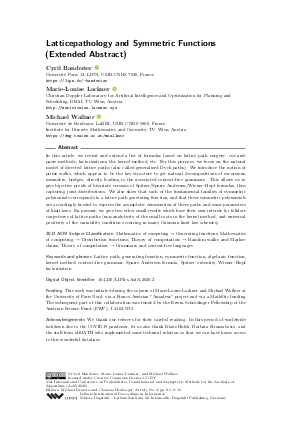@InProceedings{banderier_et_al:LIPIcs.AofA.2020.2,
author = {Banderier, Cyril and Lackner, Marie-Louise and Wallner, Michael},
title = {{Latticepathology and Symmetric Functions (Extended Abstract)}},
booktitle = {31st International Conference on Probabilistic, Combinatorial and Asymptotic Methods for the Analysis of Algorithms (AofA 2020)},
pages = {2:1--2:16},
series = {Leibniz International Proceedings in Informatics (LIPIcs)},
ISBN = {978-3-95977-147-4},
ISSN = {1868-8969},
year = {2020},
volume = {159},
editor = {Drmota, Michael and Heuberger, Clemens},
publisher = {Schloss Dagstuhl -- Leibniz-Zentrum f{\"u}r Informatik},
address = {Dagstuhl, Germany},
URL = {https://drops.dagstuhl.de/entities/document/10.4230/LIPIcs.AofA.2020.2},
URN = {urn:nbn:de:0030-drops-120329},
doi = {10.4230/LIPIcs.AofA.2020.2},
annote = {Keywords: Lattice path, generating function, symmetric function, algebraic function, kernel method, context-free grammar, Sparre Andersen formula, Spitzer’s identity, Wiener - Hopf factorization}
}

 Creative Commons Attribution 3.0 Unported license
Creative Commons Attribution 3.0 Unported license


